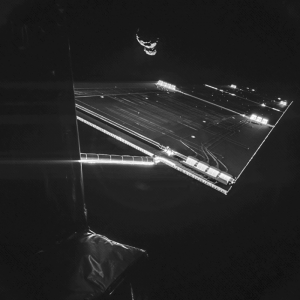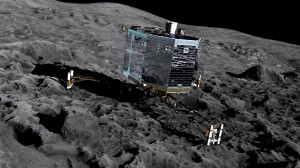
After a journey lasting over a decade, Rosetta, a spacecraft launched by the European Space Agency (ESA), has finally reached its comet destination.
On August 6, 2014, Rosetta made history as the first spacecraft to rendezvous with a comet. Having settled close to Comet 67P/Churyumov-Gerasimenko, Rosetta will continue to trace triangular loops around it. This comet, currently located about halfway between the orbits of Mars and Jupiter, hurtles through space toward the inner solar system at about 34,000 miles per hour.
Why are scientists interested in studying this object in a 6.5-year elliptical orbit? Considered to be building blocks of the solar system, comets may have helped provide Earth with not only water but also the chemical ingredients for life. However, many fundamental questions about comets remain unanswered. For example, what processes brought these primitive objects into existence? Scientists believe that the icy interiors of comets will provide clues to such processes during the early phases of the solar system.
Rosetta aims to unlock the secrets of 67P through a comprehensive study that will run for over a year. Equipped with a ten-instrument lander, Rosetta aims to study the characteristics of the comet’s nucleus, the chemical and mineralogical composition of the comet, and the development of the comet’s activity. Through its photos and data, taken both near and on the surface of the comet, Rosetta will ultimately help scientists understand the origin and the evolution of not only the comet but also the solar system.
To reach this point, Rosetta took a longwinded path, both on Earth and in space. First considered in the late 1970s, the mission was not approved by ESA’s Science Programme Committee until 1993. Even after the approval, another decade passed before its launch in 2004.
The spacecraft’s journey once off the ground proved no less challenging. To reach Comet 67P, Rosetta had to make five loops around the Sun, performing a total of four gravity-assist flybys of Earth and Mars. In total, the spacecraft has covered about four billion miles, equivalent to over 16 round trips between Earth and the Sun.
But scientists think that it was worth the journey. Within just a month of its arrival, Rosetta has already given them plenty to think about. Matt Taylor, a Rosetta project scientist, told ESA about what astronomers hope to learn from studying Comet 67P/Churyumov-Gerasimenko. “Is this double-lobed structure built from two separate comets that came together in the solar system’s history, or is it one comet that has eroded dramatically and asymmetrically over time? Rosetta, by design, is in the best place to study one of these unique objects.”

The bigger adventure, however, is yet to come. Rosetta has already begun preparations for its ultimate “space history first”: landing on a comet. On September 15, ESA announced the location that Rosetta’s lander Philae will target, and the historic landing is expected to occur on November 11.
A successful landing will mark the beginning of a new chapter in the exploration of our solar system. In Rosetta’s images and samples, we might find evidence to help understand how the sun and its planets came to be the way they are now. The search for such a clue has just begun.
